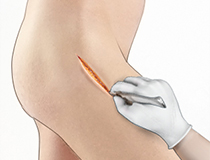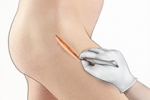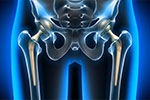
Until recently, the only definitive treatment for a hip injury was open surgery, which is performed through a large incision, with underlying tissues either cut or separated to reach the hip joint. Surgery was mostly limited to severe hip injuries or diseases, while mild-to-moderate injuries were either treated conservatively, or simply avoided until pain and disability worsened enough to merit surgery. Fortunately, recent advances in technology have changed this scenario and new minimally invasive surgical techniques are now available to treat a variety of hip conditions.
What is Minimally Invasive Surgery?
The term “minimally invasive” is used in view of the tiny incisions made on your skin in comparison to an open surgery’s large cut across the damaged area. This turns an invasive surgery into a “minimally invasive” surgery. In many cases, this involves the use of a revolutionary device called an arthroscope. The arthroscope is a long narrow fiber-optic tube that can be passed through small incisions. The light source and camera connected to this tube illuminates the surgical area and provides a clear view of the inside of your hip joint, which can be visualized on a large monitor. The arthroscope does not compromise on the overall visibility offered by an open approach as it enables a magnified and more detailed view of the problem.
The arthroscope can be used as both a diagnostic as well as therapeutic tool. Certain joint conditions are difficult to diagnose even with advanced imaging procedures, and arthroscopy provides the only definitive diagnosis. Structures that can be visualized through the scope include bone, cartilage, tendons, ligaments and muscle.
During surgery, the arthroscope is introduced through one tiny incision and miniature instruments inserted through other small incisions to repair or treat a hip problem. These instruments are designed to cut, trim, shave, smooth out or stitch up damaged areas of the hip joint. Hip arthroscopy can be used to determine the extent of inflammation or injury to the structures of the hip region. Some conditions treated by hip arthroscopy include:
- Articular cartilage injury: Injury to the smooth cartilage that lines the ends of the bones in the hip joint and allows them to glide over each other during movement
- Labral tears: Tears in the labrum, a raised ridge of cartilage surrounding the pelvic socket, which provides stability to the joint and attachment for muscles
- Loose bodies: Dislodged pieces of bone or cartilage within the joint as a result of injury
- Hip impingement: Abnormal bone growth that interfere with the smooth articular surface and friction-free movement of the bones of the hip joint
Benefits of MIS
Minimally invasive arthroscopy has numerous advantages over open surgery. The small incisions allow:
- Little damage to surrounding tissues, which in turn helps in postoperative healing and function of these tissues
- Less blood loss
- Decreased postoperative pain
- Minimal complications
- Shorter hospital stay
- Faster recovery
- Less scarring
Robotically-Assisted Surgery
A further advancement to minimally invasive surgery is robotically-assisted minimally invasive surgery, which increases the accuracy and precision of a hip procedure. A robot-assisted surgery is performed using a robotic arm that is guided by the surgeon. The use of a robot adds to the advantages of minimally invasive treatments with increased dexterity, better visualization and allows surgeons to perform procedures that were previously unfeasible or technically difficult to perform.
As technology builds on the importance of patient comfort along with optimum treatment outcomes, we are excited to see more innovations in technology as well as techniques to better treat hip problems and provide improved overall care to our patients.
Dr. Domb is a nationally recognized orthopaedic surgeon specializing in sports medicine and arthroscopic surgery of the hip, shoulder and knee. A noted pioneer in advanced new techniques in hip arthroscopy, he delivers innovative treatments for patients with hip injuries such as impingement and labral tears. Dr. Domb is also an expert in arthroscopic surgery of the shoulder and knee, adept in specialized techniques including arthroscopic rotator cuff repair and all-inside ACL reconstruction.





